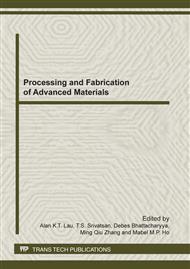p.263
p.267
p.271
p.275
p.279
p.283
p.287
p.291
p.298
Burr Size Reduction in Drilling of Al/SiC Metal Matrix Composite by Ultrasonic Assistance
Abstract:
Metal matrix composites (MMCs) have received considerable attention due to their excellent engineering properties. Accuracy and surface finish play an important role in modern industry. Undesired projections of materials, known as burrs, reduce the part quality and negatively affect the assembly process. In this study, reducing burr size in drilling of MMC is performed by adding ultrasonic vibration to the process. Al/SiCp MMC with 5 wt% of SiC particulates in dry drilling operation with HSS drill tools coated with TiN was investigated. The effect of ultrasonic assistance on burr size was studied. The results demonstrate that under suitable ultrasonic vibration conditions, in comparison with the conventional drilling, the burr height and width could be reduced.
Info:
Periodical:
Pages:
279-282
Citation:
Online since:
November 2011
Authors:
Price:
Сopyright:
© 2012 Trans Tech Publications Ltd. All Rights Reserved
Share:
Citation:


